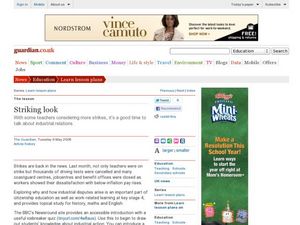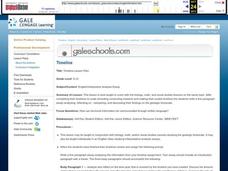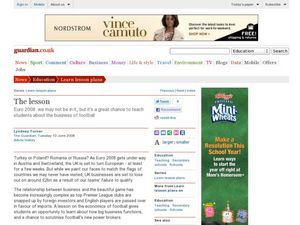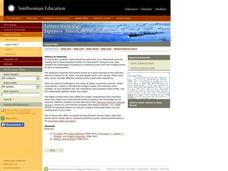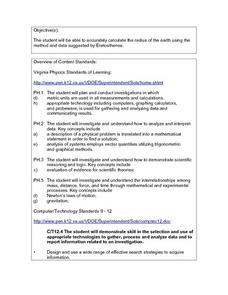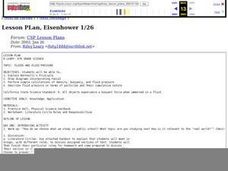Curated OER
Art and Anatomy: The Vitruvian Teen
Students are introduced to the history of showing the human anatomy. In groups, they measure their height and arm spans to create a graph and determine if their measurements support Vitruvius' work. Individually, they make their own...
Curated OER
Playing the Cardboard Dulcimer
Second graders create cardboard dulcimers. They discover that sound is produced by vibrating strings and analyze the pitch produced by changing the sizes and length of the strings of the instrument. They also discuss the history of the...
Curated OER
Mosaics of Cyprus
Students create digital mosaics. In this visual arts activity, students discover the attributes and history of mosaics in a teacher-led discussion. Students use an educational program to make their own digital mosaics.
Curated OER
GET'N JIGGY WITH THE JITTERBUG
Twelfth graders research the history of the jitterbug dance through an interactive group project. The goal of the lesson is to get them to execute the dance steps independently with little outside help from the teacher. The steps are...
Curated OER
Techno Timeline
Students create a timeline of inventors. In this dual history/science instructional activity, students research inventors of technological products, then work in groups to create a timeline of events. The timeline may include science...
Curated OER
Striking Look
Young scholars examine teacher union issues. In this current events lesson, students browse selected websites to explore the work and history of labor unions in Great Britain in order to better understand the teacher strikes of 2008.
Curated OER
Timeline
Students develop a timeline that depicts geologic development and the history of life. They write an interpretive analysis essay that discusses and reflects on their observations.
Curated OER
Harvest Happenings
Students explore the history of agriculture and develop a personal connection to agriculture. Students investigate how farming practices have evolved through the years and create poetry relating to harvest.
Curated OER
Survival or Democracy?
Students take a closer look at Pakistan today. In this current events lesson, students visit selected websites to discover a history of the country, the cultural values of its citizens, and structure of the of the government there.
Curated OER
Thanksgiving Web Quest
Students review the reasons why Thanksgiving is celebrated in the United States. Using the internet, they research the history of the holiday and discover what the first Thanksgiving was like. They also examine a typical menu for a...
Curated OER
A Gift to Give
Students investigate the holiday Kwanzaa by drawing pictures. In this cultural tradition lesson, students discuss the history and actions that take place during the holiday of Kwanzaa. Students draw a picture of a gift they would give to...
Curated OER
Cotton And Child Labor
Eleventh graders investigate the practice of child labor as found in the history of the United States. The teacher reads the class a story from the year of 1914. This creates context for the lesson and then students answer teacher...
Curated OER
Euro 2008
Students discover details about the world of British football. For this current events lesson, students browse selected websites to explore the work and history of the game, the Euro 2008, and the business aspects of the game in Britain.
Curated OER
Breath of Fresh Air
Students consider the historical and social aspects of smoking. In this current events lesson, students research passive smoking, smoking legislation, and smoking history in the United Kingdom as they visit the listed websites.
Curated OER
Letters from the Japanese American Internment
Students examine letters of Japanese-American children during internment in World War II. They discover what it was like in the camps and how they were treated once they were released. They also view photographs of the camps.
Curated OER
Striking It Rich!
Fifth graders explore the California Gold Rush. They explore the lure of gold and the Wild West, how pioneers traveled to the West, and the hardships and people they encountered along the way. Activities be authentic, hands-on, and...
Curated OER
The Price of Relief
Students calculate and graph the costs of essential items needed in Kosovar refugee camps on an individual, family, and camp basis. Additionally, students explore how relief organizations and businesses participate in relief efforts.
Curated OER
Making Paper
Students explore paper making. In this cross curriculum multicultural ecology and art lesson, students follow written and oral instructions to make paper using common household items. Students predict the amount of paper use in their...
Curated OER
Looking into Eratosthenes' Radius of the Earth
Students, in small groups, research Eratosthenes and his calculations of the Earth's radius. They write a summary of the person, the experiments and his calculations to determine how accurate Eratosthenes was in his estimations of the...
Curated OER
Eisenhower 1/26
Eighth graders identify and explain what Bernoulli's Principle is and draw diagrams to incorporate Pascal. They also perform simple calculations of density, buoyancy, and fluid pressure. Finally, 8th graders describe fluid pressure in...
Curated OER
Moon Mining
Go on a moon mining expedition from the safety of your classroom with this space exploration simulation. Using simple models of the moon's surface prepared ahead of time by the teacher, young scientists are challenged with locating and...
California Academy of Science
Fresh Solutions: Design Thinking Challenge
How do people transport fresh water long distances to ensure everyone has access to it? The final lesson in the 10-part Fresh Solutions unit encourages individuals to design their own solution, or solutions, to that very problem. Groups...
Curated OER
An Immigration Graph
Students practice reading and understanding information in a table and converting the information to graph form. They create a graph showing the number of immigrants per country of origin between 1899 and 1924.
Curated OER
Anamorphosis
Students classify optical illusions according to their distinguishing characteristics. They create anamorphic art and use Mylar flexible mirrors to view and then they describe and analyze the optical illusion.
Other popular searches
- History of Mathematics
- Math History
- Black History Month Math
- History of Mathematics India
- The History of Mathematics
- Basic Facts Math History
- Math History Biography
- Women History and Math
- Math History & China
- Roman Numerals Math History
- History Discrete Mathematics
- Math History Root Words





